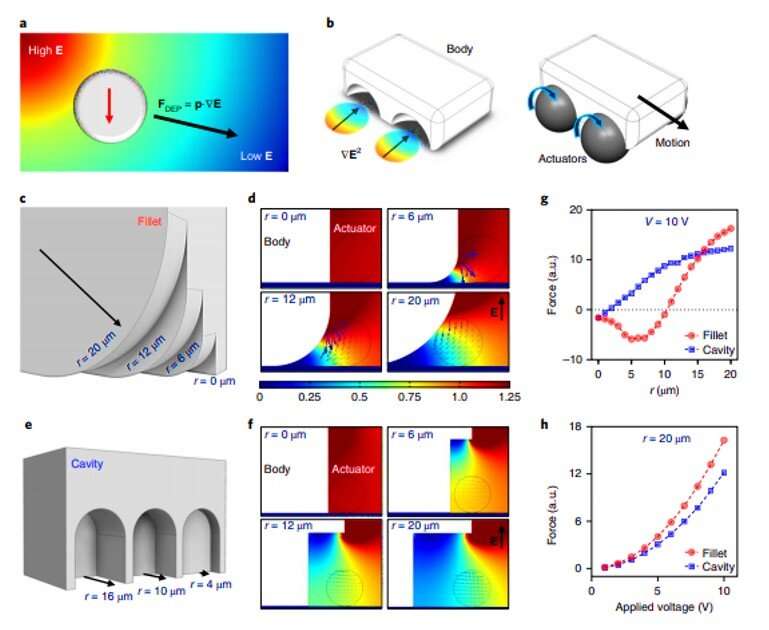

| Date | 15th, Jul 2019 |
|---|
 Shape-encoded assembly of magnetic microactuators in the form of a microvehicle. Credit: Nature Materials, doi: 10.1038/s41563-019-0407-3
Shape-encoded assembly of magnetic microactuators in the form of a microvehicle. Credit: Nature Materials, doi: 10.1038/s41563-019-0407-3
Field-directed and self-propelled colloidal assembly can be used to build micromachines to perform complex motions and functions, although their integration as heterogenous components with specified structures, dynamics and functions within micromachines is challenging. In a recent study on Nature Materials, Yunus Alapan and co-workers at the departments of physical intelligence and complex materials in Germany and Switzerland described the dynamic self-assembly of mobile micromachines with desired configurations using preprogrammed physical interactions between structural and motor units.
They drove the assembly using dielectrophoretic interactions (DEP) encoded in a three-dimensional shape (3-D) of individual parts. They followed the protocol by assembling the new micromachines with magnetic and self-propelled motor parts for reconfigurable locomotion and additional degrees of freedom hitherto unrealized with conventional monolithic microrobots. The site-selective assembly strategy was versatile and could be demonstrated on different, reconfigurable, hierarchical and three-dimensional (3-D) mobile micromachines. The scientists anticipate the design principles presented in the work to advance and inspire the development of more sophisticated micromachines integrated in multiscale hierarchical systems.
Mobile micromachines offer significant potential to probe and manipulate the microscopic world and create functional order/assemblies at the micro- and meso-scale. A micromachine can be composed of multiple parts, materials or chemistries to address multiple functions, including actuation, sensing, transport and delivery. Functional modes and performance of a micromachine can be dictated by the collective organization and interaction of its constituents.
For instance, magnetic particles interacting under rotating magnetic fields can assemble into chains or wheels capable of moving close to solid surfaces. Similarly, scientists have developed light-activated microswimmers within living crystals and allowed self-rotation by regulating the chemical consumption. To design higher complexity, bioengineers and materials scientists must allow programmable physical interactions into individual parts for shape- and material-specific actions under external influences. Examples include the development of composite microstructures assembled as colloids using virtual electric and magnetic molds.
While new approaches have shown promise to build programmable structural assemblies, these remain to be translated into mobile micromachine assemblies. In the present work, Alapan et al. introduced a directed assembly process to build mobile compound micromachines using dielectrophoretic (DEP) forces to encode precisely controlled distribution of electric field gradients around a body by modulating its 3-D geometry.
The results showed site-selective and directional microactuators with a versatile shape-encoded assembly strategy. They showed the possibility of improved strengthening between the actuators and the body by tuning the DEP forces to provide control on rotation. Alapan et al. implemented a new design strategy of directed assembly to control operational dynamics between functional components using shape-encoded DEP forces. The experimental work will provide a rich design space to develop functional micromachines and mobile microbots to perform complex tasks.
 Spatial encoding of DEP attraction sites by modulating the 3D geometry. (a), A negatively polarized particle, with a lower relative permittivity than the medium (εp< εm) experiences a DEP force towards the lower field magnitudes under a non-uniform electric field. (b), DEP forces can be exploited for the encoded assembly of functional components by controlling local electric field gradients generated around a body through its geometry. (c–f), Different 3D surface profiles (fillet or cavity) of a solid body alter the electric field strength around the body (c,e), creating local gradients around the surface profiles depending on the feature dimension, r (d,f). Arrows represent electric field gradients inside the circular region representing a microactuator (10 µm diameter), which is located at the point of maximum force. Color bar normalized electric field strength (E/E0)2. (g,h), Negatively polarized smaller actuators experience a DEP force towards (F> 0) or away (F
Spatial encoding of DEP attraction sites by modulating the 3D geometry. (a), A negatively polarized particle, with a lower relative permittivity than the medium (εp< εm) experiences a DEP force towards the lower field magnitudes under a non-uniform electric field. (b), DEP forces can be exploited for the encoded assembly of functional components by controlling local electric field gradients generated around a body through its geometry. (c–f), Different 3D surface profiles (fillet or cavity) of a solid body alter the electric field strength around the body (c,e), creating local gradients around the surface profiles depending on the feature dimension, r (d,f). Arrows represent electric field gradients inside the circular region representing a microactuator (10 µm diameter), which is located at the point of maximum force. Color bar normalized electric field strength (E/E0)2. (g,h), Negatively polarized smaller actuators experience a DEP force towards (F> 0) or away (F